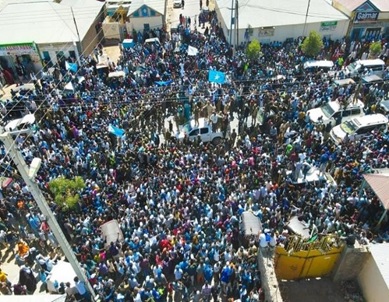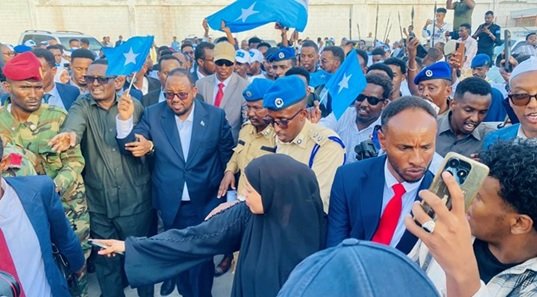By Mohamed A Mire
The much-vaunted secessionist enclave, known as Somaliland and situated in northern Somalia, finds itself at the precipice of collapse. This impending upheaval is the result of a remarkable and recent defeat suffered by its military forces in the Sool region at the hands of SSC (Sool, Sanaag, and Cayn) forces. The potential downfall of this self-proclaimed state, often lauded as a symbol of peace and a stronghold of democracy in Africa by its staunch proponents, has become a source of profound disillusionment. This disappointment extends beyond those intimately involved, encompassing foreign political figures like Matt Bryden, a Canadian who has faded into obscurity, as well as individuals such as Gavin Williams, a member of the British parliament, and Dr. J. Peter Pham from the US, who continue to be actively involved, at times appearing as theatrical performers.

It’s noteworthy that Mr. Gavin Williams visited Somaliland just weeks before the SSC regions were liberated from the grip of Somaliland, ending a 15-year occupation. During his visit, Mr. Williams ardently championed Somaliland’s narrative of independence from Somalia, vigorously advocating for its recognition by his parliament. Little did he know, as he toured Somaliland, that the descendants of the Dervish fighters in the SSC regions, who had once battled his forefathers in Northern Somalia (Dervish land) between 1890 and 1920, were meticulously finalizing plans that would ultimately lead to the eviction of Somaliland’s armed forces from the SSC regions?
Today, the Somaliland envisioned by secessionists, with all its arrogance and empty boasts, is steadily dissipating, akin to ice melting on the scorching sands of a desert. For Mr. Williams and Mr. Pham, the thrill they once experienced has evaporated.
The narrative of Somaliland’s military facing a significant defeat and losing control of the SSC regions finds its roots in the events of December 26th of the last year. On that fateful day, a promising local politician named Hadrawi was deliberately shot dead by Somaliland militia in Lasanod. This tragic event reopened a long-festering wound of anger within the SSC people. Their anger had been boiling for years, aggravated by the grim reality that over 130 prominent individuals from Lasanod had met a similar fate at the hands of the Somaliland militia since 2007 when Somaliland occupied Lasanod. Added to this resentment was the SSC people’s suspicion that the Somaliland regime was covertly planning to displace them from Dervish land to gain control over the oil-rich Holhol well within the SSC region. This suspicion, along with covert assassinations, frequent arrests, and other repressive measures against the SSC people, had been brewing anger in the minds of the SSC populace.
Following the killing of Hadrawi, the SSC community’s simmering frustration and suspicion began to boil over. This heart-breaking incident served as a catalyst for their collective outrage, signalling that their very existence was under threat, and their anger was now palpable. The events that followed were a testament to this mounting anger and the SSC people’s unwavering determination to protect their land and resources. This critical turning point marked the beginning of a struggle that would unfold over time, ultimately resulting in a significant shift in the region’s dynamics.
After Hadrawi’s tragic assassination, the residents of Lasanod initiated a peaceful protest in the days following his death, demanding justice and accountability. Regrettably, their plea for peace was met with brutal reprisals from the Somaliland militia, who subjected the entire city to shelling, resulting in the loss of more than 27 innocent lives. This ruthless response further fuelled the blustering resentment within the population. Thousands of enraged citizens flooded the streets, defiantly waving the blue flag as a symbol of their unity and unwavering resolve. The entire city of Lasanod was engulfed in a sea of blue, an inspiring phenomenon aptly termed the “blue wave,” which gave birth to the organized youth movement known as “Jamahiirta.” People from all walks of life rallied to the cause, with heroines like Fahima Quuje, Rahma Yar, and Ferdous Ibrahim A Shire, a qualified nurse from the UK who tirelessly cared for the wounded amidst the bombing of health facilities, becoming symbols of the uprising. Additionally, individuals like Ahmed Saakin, a former member of the Somali parliament, worked tirelessly to convey the situation of the city to the SSC diaspora.
Furthermore, Garad Jama Garad Ismail, a widely recognized and eloquent traditional leader who had previously been perceived as aligned with Somaliland, threw his support behind the “Jamahiirta” movement. His influential endorsement resonated across the region, prompting all 14 traditional leaders of the SSC, including Garad Jama Garad Ali and Garad Abdirasak Garad Soofe, who had staunchly opposed the Somaliland regime, to come together and unite in the uprising.
Moreover, a pivotal moment came when Abdirasak Khalif, the then-Speaker of the Somaliland parliament, a skilled politician hailing from the SSC regions, defected to support his people’s demands and joined the opposition against Somaliland’s occupation. This defection represented more than a turning point in the ongoing struggle; it also redefined the political landscape of Somaliland. Notably, Somaliland now primarily comprises without SSC important persons, it has only individuals like Suleiman Y. Ali Koore, the “foreign minister,” and Yasiin M Faratoon, the “current parliament speaker,” who are mere quislings in the eyes of the SSC people.
As the protests continued and unity among the SSC (Sool, Sanaag, and Cayn) people grew stronger, a historic declaration emerged on February 6th, following a month-long meeting convened in Lasanod by the 14 traditional leaders and 33-member provisional council. During this meeting, which commenced on 6th Jan, the SSC traditional leaders boldly proclaimed its independence as a Khatumo state while maintaining its affiliation with the Somali Federal Government. This declaration sent shockwaves through the Somaliland regime, leading to the massing of its army on the outskirts of Lasanod.
Nearly the entire Somaliland army fortified itself in positions in Gojacade and Maraga, both strategically situated few kilometers from the city center. From these vantage points, the Somaliland forces launched a sustained and indiscriminate shelling campaign against the city. This relentless bombardment endured for a harrowing eight months, leaving in its wake the heart-breaking destruction of hospitals, mosques, schools, and the tragic loss of hundreds of innocent lives. Consequently, this onslaught forced approximately 200,000 residents to seek refuge elsewhere of the country.
In response, the SSC forces intensified their resistance to the Somaliland army, receiving assistance from their blood-related kin in the Harti clans who mobilized substantial forces to bolster the fight. Ultimately, a turning point came when, after eight months of continuous shelling of Lasanod by Somaliland forces and one week after the killing of Jama Kediye, a renowned poet throughout Somalia, the SSC and Harti forces, executed a swift and surprising military operation. In just three hours, they defeated the much-praised, 30-year-old Somaliland army, resulting in the death of over a thousand soldiers, the seizure of significant arms caches, and the capture of nearly 500 prisoners. The Somaliland forces were forced to retreat 150 kilometers away from Lasanod, thereby liberating all of Dervish land from the Somaliland occupiers.

One month after the events of August 25th, when the Somaliland army was defeated in Lasanod, the SSC people took significant steps forward. They organized elections, establishing a parliament, appointing a head of state, and forming a cabinet. The SSC regions now boast a fully functional government that represents the SSC Khatumo state, positioning itself to become a member state of the Federal Republic of Somalia.
Remarkably, this week witnessed a momentous event. A delegation led by the President of SSC Khatumo state, accompanied by ministers and seasoned advisors, journeyed to Mogadishu in response to an invitation extended by the Prime Minister of the Federal Republic of Somalia. However, what truly tugged at the heartstrings of many was the profound moment when Mr. Abdilkadir Ahmed Aw Ali Firdhiye, the President of SSC Khatumo state, disembarked from the plane, proudly waving the blue flag—a symbol of unity. This gesture served as a poignant reminder of the historic day in 1960 when the very same flag was transported from Hargeisa to Mogadishu by Somali patriots from the north. This powerful and symbolic act resonated deeply with all Somalis who have harbored a fervent longing for the unity of their country.
Now that the secession has been thwarted by the descendants of the Dervishes and the SSC territories are free, residents who had fled at the onset of the conflict are returning to the city, and the people of SSC are now eagerly working to rebuild their city.
The positive impact of this liberation goes beyond merely reinforcing and rejuvenating Somali unity. We hold the hope that the “blue wave” of unity and the movement of “Jamahiirta” will persist and spread to other regions that are under the control of Somaliland, notably in Awdal, where tensions against the Somaliland secessionists have been festering.
My hope, as a descendant of Dervishes, extends even further, aspiring to a day, perhaps not in my lifetime, when the blue flag will proudly wave over all Somali-inhabited territories. History has shown that the legitimate aspirations of a people may ebb, but they never truly fade away.
Mohamed A Mire
Email: [email protected]
We welcome the submission of all articles for possible publication on WardheerNews.com. WardheerNews will only consider articles sent exclusively. Please email your article today . Opinions expressed in this article are those of the author and do not necessarily reflect the views of WardheerNews.
WardheerNew’s tolerance platform is engaging with diversity of opinion, political ideology and self-expression. Tolerance is a necessary ingredient for creativity and civility.Tolerance fuels tenacity and audacity.
WardheerNews waxay tixgelin gaara siinaysaa maqaaladaha sida gaarka ah loogu soo diro ee aan lagu daabicin goobo kale. Maqaalkani wuxuu ka turjumayaa aragtida Qoraaga loomana fasiran karo tan WardheerNews.
Copyright © 2024 WardheerNews, All rights reserved


